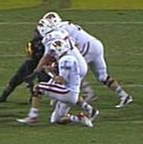Really, How Hard Is It to Down a Ball?
Published on 15-Sep-2013 by J Square Humboldt
Share this article

Referees are paid to keep a game under control.
And given the technology available to football coverage, they have an often-maddening interminably amount of time to do it.
So how does a Pac-12 officiating crew allow something like this to happen at the end of a game:
First of all, give the broadcaster credit for warning his viewers that "a lot of dangerous things can happen here."
Secondly, going to freeze-frame after listening to his commentary, here's what he missed:

Wisconsin quarterback Joel Stave indeed dropped a knee.
The broadcaster can be excused for not noticing. He can correct himself later.
But wait a moment. Can't the officials do that, too?
And yes, that's a rhetorical question.
How, with a police state's inventory of cameras available to the replay officials upstairs, do they not buzz down to the head referee and put the old 'under further review' delay into play?
Fans will offer their own perspectives on this incident for a while -- and then some -- and arcane passages from the rule book will be cited, but all that noise is irrelevant.
Dude was down.
Rewind and take it from there. Referees have the power to order it so. Good referees would have done it.
This is just the latest example of why many in major league baseball remain skeptical of adding more replay to their game. Stuff like this, albeit less dramatic, occurs almost every weekend in both the pro and college games. How so much incompetence exists in the process is not really a mystery.
The human error now hides behind the technology.
And at the end of the Wisconsin-Arizona State game, the human error happened in spite of the technology.
The game was out of control, and there was no excuse for it. Absolutely none.

